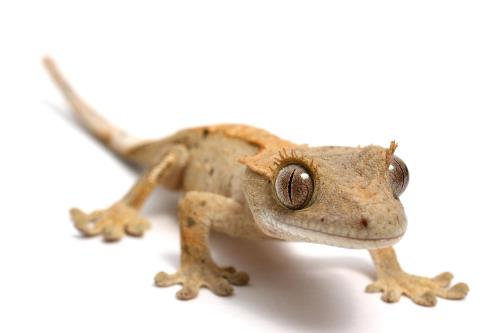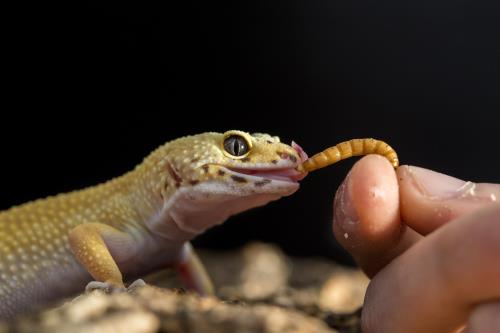10 Pet Lizard Types for Reptile Lovers
You're mesmerized by the agile movements, curious eyes and colorful markings on lizards, but which specific breeds might you find peering back at you at your local pet store or reptile swap (aka animal expo)? We're so glad you asked!
We've rounded up the top ten most common pet lizard types for you to investigate and consider adding to your family.

First, is your home ready for a pet lizard? Run through this quick checklist of questions before making a final decision.
- Do you have space for a terrarium in your home?
- Can it sit on an elevated table or shelf, away from dogs and/or curious toddlers?
- Are you okay with feeding live foods (insects, mice, etc.) to a pet lizard?
- Are your children old enough to understand safe handling guidance? (Hand washing and gentle touch are musts with lizards!)
- Do you have time to love and care for a new pet?
If those were all 'yes' answers, let's get to know a few of the most popular varieties of lizards.
10 Pet Lizard Types to Consider
- Bearded Dragon
Also known as "beardies," the bearded dragon is native to Australia. This lizard is a pro at adapting to extreme temperatures and moisture shifts, making it an easy beginner reptile for herp enthusiasts. Bearded dragons tend to be calm and friendly. Beardies are omnivores that like to gobble up both plant and animal foods, including insects, mealworms, collard greens and dandelion greens. - Chameleon
This type of lizard comes in over 200 types, including the popular veiled chameleon, Jackson's chameleon and pygmy chameleon. The most friendly of the bunch is the veiled chameleon, which originates in Saudi Arabia and Yemen. Chameleons don't tolerate much handling and are best admired through the glass of their habitat. An occasional short stroll over your fingers then back onto a branch in their home is more than enough stimulation. The veiled chameleon is insectivorous and dines on crickets, mealworms, superworms, waxworms and roaches supplemented with calcium and vitamins. - Crested Gecko
The cute crested gecko comes to us from the island of New Caledonia. They enjoy some handling, especially the freedom to roam around on your hand or arm. They are docile and easy to manage. This type of gecko would make a good family pet for a household with older children. Crested geckos are omnivorous and do well with a commercial gecko diet, feeder insects (such as crickets and Reptile Munchies Mealworms) and an occasional treat of freshly diced tropical fruits. - Green Anole
You'll find brown and green anoles scurrying around the southern parts of the United States, including Georgia and South Carolina. While these lizards aren't aggressive, they are fast, making them fun to watch but hard to hold or pet. Because they're so speedy, they're best suited for a patient, attentive teenager or adult. Anoles enjoy eating insects and spiders, including small crickets. - Iguana
While many lizards manage to stay hand-size or smaller, iguanas can grow to three to six feet long and weigh up to 20 pounds. They are native to Central America and South America. They make great pets for adults who will be mindful of their large claws. They are generally a calm pet, but they may bite (which can be painful) if provoked. Iguanas are herbivores that prefer to munch on leaves, flowers and fruits such as dark leafy greens, dandelions, clover, marigolds, apple blossoms, bell peppers and cucumbers. You can also offer them pelleted iguana food. - Leopard Gecko
This pet lizard originates in the Middle Eastern countries of Iraq, Iran, Afghanistan and India. They are known as very hardy and calm pets, making them a top seller at pet stores. In the wild, you'll find leopard geckos catching insects for their meals. As pets, they thrive well on crickets, mealworms, waxworms, superworms and roaches boosted with nutrient-rich Gut Load Cricket Drink. - Monitor
About 80 species of monitor lizards live in the grasslands, savannahs and rocky terrain of Africa, Asia and Oceania. The savannah monitor is a good pet option for an adult who can spend lots of time and have a lot of patience with the reptile. When handled gently as a juvenile, an adult monitor will generally be docile and calm. Some species of monitors are carnivores. Savannah monitors kept as pets do well on an insect diet of crickets, mealworms, waxworms and roaches. - Skink (Blue Tongue)
You will find the blue-tongue skink naturally roaming the woodlands and fields of Australia, New Guinea and Indonesia. As juveniles, skinks appear nervous and cautious around humans. They will mature into docile adult pets with consistently gentle interactions, like allowing them to walk on your hands. The blue-tongue skink is an omnivore. In captivity, they enjoy a mix of chopped carrots, mustard greens, dandelion greens, crickets, mealworms and waxworms. - Tegu
These South and Central American lizards are common in Brazil, Paraguay and northern Argentina. The Argentine black and white tegu, red tegus and gold tegus may also be found roaming Florida properties. Tegus tend to be docile but grow up to four feet long, making them best suited for experienced reptile handlers. These lizards are omnivores, eating a variety of fruits, eggs from ground nesting birds, small reptiles and rodents. - Uromastyx
The final pet lizard on our list is the uromastyx, also known as an "uro" or dabb lizard. They are native to northern Africa, the Middle East, and south-central Asia. Uros are known for their gentle demeanor. However, you should expect a tail whip or verbal gasp if they are startled while snoozing. Uromastyx enjoys eating a mix of greens, including the leafy portions of dandelions, collards, mustard, turnip, endive and bok choy, with a sprinkle of grated squash, carrots or sweet potato on top. Uros also enjoy grass seed, safflower seeds and an occasional cricket for a treat.

Quick tip: Before bringing a new pet home, have a properly set up reptile habitat ready to go and food on hand. This makes the transition easier on both you and your new lizard.
As you decide what type of lizard might make a good pet for your household (there are so many great options!), browse this guide on Lizard & Gecko Facts to learn more about habitat needs, safe handling and feeding practices.
